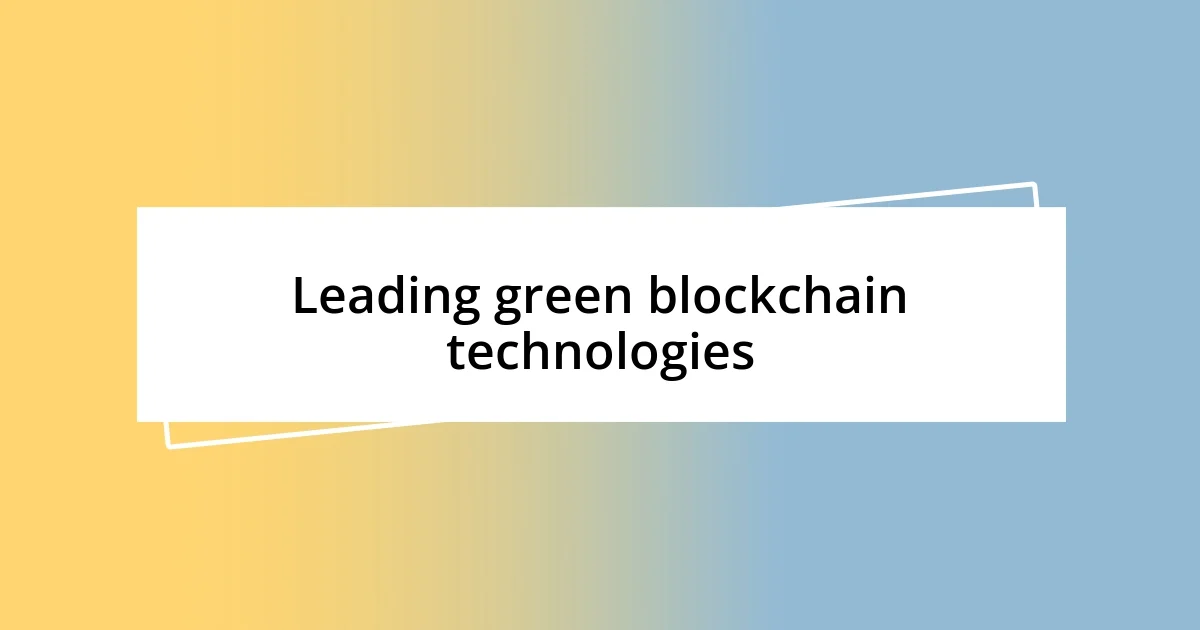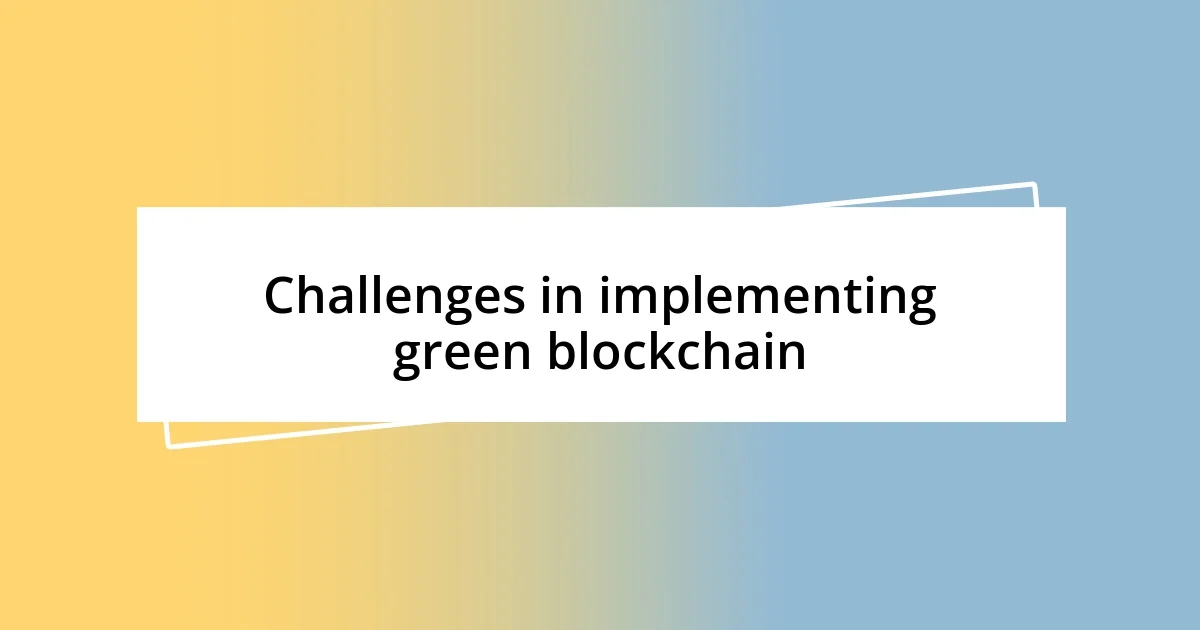Key takeaways:
- Green blockchain solutions utilize energy-efficient mechanisms like proof-of-stake to significantly reduce energy consumption and carbon footprints compared to traditional proof-of-work systems.
- Leading technologies such as Algorand, Tezos, and Hedera Hashgraph showcase innovative approaches that enhance transaction speed and efficiency while promoting sustainability.
- Challenges in implementing green blockchain include high initial investments, scalability issues, and the complexity of regulatory compliance, which can hinder widespread adoption.

Understanding green blockchain solutions
Green blockchain solutions are fascinating because they combine cutting-edge technology with sustainability. For instance, when I first learned about proof-of-stake models, it struck me how they significantly reduce energy consumption compared to traditional proof-of-work systems. It made me question—how can we harness this potential to create a greener digital future?
I often reflect on my experience attending a conference where experts discussed the power of renewable energy sources for blockchain operations. One speaker shared a project that utilized solar energy to power mining operations, which not only reduced carbon footprints but also created local jobs. This blend of technology and environmental stewardship left me inspired.
It’s intriguing to consider the broader implications of green blockchain solutions. These initiatives can help address climate change while maintaining the integrity and security of transactions. When I think about the potential here, I can’t help but wonder—could embracing green practices in blockchain be a catalyst for wider change in other industries?

Importance of sustainability in blockchain
Sustainability in blockchain is not just a trend; it’s becoming a necessity. From my perspective, the energy consumption associated with traditional blockchain technologies can lead to significant environmental issues. I remember a conversation with a fellow enthusiast who passionately advocated for more energy-efficient systems. This discussion opened my eyes to the urgent need for sustainable practices within the blockchain realm.
I once attended a workshop where innovators showcased how eco-friendly consensus mechanisms are reshaping the industry. They emphasized that a sustainable blockchain does not sacrifice security for energy efficiency. This balance struck a chord with me. By embracing greener solutions, we can protect the environment while still leveraging the reliability that blockchain offers. It’s about finding that sweet spot where technology meets responsibility.
As I reflect on the future, I see sustainability as a key driver of blockchain’s evolution. When widely adopted, green solutions can inspire other sectors to pursue similar paths, fostering a culture of accountability and eco-awareness. Just think about it: what if all technologies followed suit to create a more sustainable economy? The potential impact genuinely excites me.
| Traditional Blockchain | Green Blockchain |
|---|---|
| High energy consumption | Significantly lower energy usage |
| Environmental impact | Minimal carbon footprint |
| Proof-of-work consensus | Proof-of-stake and other green alternatives |
| Limited scalability | Enhanced scalability and efficiency |

Key features of green blockchain
The key features of green blockchain solutions reflect a shift toward responsible innovation in technology. From my experience engaging with various projects in this field, I’ve seen that many green blockchains prioritize energy efficiency through innovative consensus mechanisms like proof-of-stake. This method not only conserves power but also enhances transaction speeds, which was refreshing to learn at a recent meetup where I connected with developers focused on sustainable practices.
A standout feature of green blockchain is its commitment to transparency and traceability. Blockchain’s inherent ability to provide a public ledger means that stakeholders can track the carbon footprint of their transactions. At a previous conference, I heard a passionate advocate discuss how this feature fosters accountability, encouraging businesses to be more thoughtful about their environmental impact. Here are some key attributes that define green blockchain solutions:
- Energy-efficient consensus mechanisms: Techniques like proof-of-stake or delegated proof-of-stake drastically reduce energy use.
- Use of renewable energy: Many green blockchains operate using solar, wind, or hydroelectric power.
- Enhanced scalability: Improvements in technology allow for better scaling without a proportional increase in energy requirements.
- Transparency in operations: The public ledger enables tracking of energy consumption and carbon footprint associated with transactions.
- Community-driven initiatives: Many projects emphasize inclusivity, inviting community feedback to improve sustainability efforts.
These features make green blockchain not just a technical advancement but a revolutionary step toward a sustainable digital landscape.

Leading green blockchain technologies
It’s fascinating to see how leading green blockchain technologies are emerging as game-changers in the industry. One example that struck me was Algorand. I remember initially hearing about their use of a unique consensus mechanism that requires far less energy than the traditional proof-of-work models. The moment I grasped how they achieved immediate transaction finality with minimal carbon output, I felt a surge of hope for the future of blockchain. Can you imagine if every blockchain could operate this sustainably?
Another innovation worth mentioning is Tezos. When I first learned about its self-amending feature, I was genuinely intrigued. This approach not only allows the network to upgrade itself without the often contentious forking process but also helps to maintain energy efficiency. Attending a session on Tezos, I felt invigorated by the idea that a community-driven model could fuel both technological advancements and environmental responsibility. It really made me wonder: what if more projects adopted similar philosophies?
Last but not least, the rise of Hedera Hashgraph highlights a significant leap in efficiency. During a recent discussion with a tech-savvy friend, I was amazed to hear how Hedera boasts a transaction speed that could rival traditional payment systems while consuming a fraction of the energy. I often think about the implications of such innovations. If these technologies gain widespread adoption, we might just be on the brink of a greener, more efficient digital economy. Does that not excite you as well?

Case studies of successful applications
One compelling case study I encountered was with the Energy Web Chain, which is designed specifically for the energy sector. I was genuinely impressed when the project shared their partnership with various renewable energy providers to create a blockchain that tracks clean energy certificates. The way this initiative empowers consumers to verify their energy sources made me think about how crucial transparency is in our journey to sustainability.
Another intriguing example is the use of blockchain in supply chain management, particularly with Provenance. I remember attending a workshop where they showcased how their platform allows consumers to trace the journey of products, like coffee or textiles, from source to shelf. This not only promotes ethical sourcing but also engages consumers in a way that makes them more conscious of their choices. It’s fascinating to consider: can we really shift consumer behavior through technology?
I also found it inspiring to see how British multinational retailer Unilever embraced blockchain for its Sustainable Living Plan. During a recent discussion with peers in the tech community, it struck me that by employing blockchain, Unilever is able to share data with suppliers about sustainable practices. This collaboration enhances accountability and drives positive change throughout the supply chain. I often wonder, how many corporations could follow suit and make a significant impact if they invested in similar technologies?

Challenges in implementing green blockchain
One of the most significant challenges I see in implementing green blockchain solutions is the initial investment required. When I first looked into the costs associated with transitioning from traditional systems, I realized how daunting it can be for organizations. It’s like deciding to renovate an entire house; the upfront expenses can be overwhelming, and not every company is ready to take that leap. How many businesses would prioritize sustainability if the financial burden weren’t so great?
Another issue that frequently comes up is scalability. In my experience, many green blockchain technologies start off strong but struggle to maintain efficiency as they grow. Take for instance my enthusiasm when I discovered a green project that handled transactions smoothly at first. As its user base expanded, I observed a noticeable dip in performance. It makes me wonder: how can we ensure that these eco-friendly solutions can grow without compromising their sustainable principles?
Finally, there’s the complexity of regulatory compliance. Navigating the legal landscape is often more intricate than many expect. I recall discussing this with a group of blockchain enthusiasts, and we collectively acknowledged how challenging it can be to align innovative solutions with existing regulations. If the laws aren’t clear or supportive of green initiatives, can we truly expect companies to adopt these technologies wholeheartedly? It’s a tough balance to strike, and I believe that clear guidance from regulators could make a world of difference in promoting green blockchain solutions.














